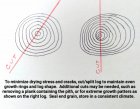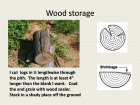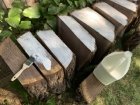(sorry, looks like my typing got the best of me...)
Bruce, you're getting good advice. Things to consider-
- Your local climate. We are in late fall/winter now. In my MN, this generally means cold and dry. In my former northern ID/southeastern WA, this usually meant somewhat warmer and a bit more moist/humid. In the southern USA, well, winter weather varies greatly. The point, cold air can't hold the humidity of warm air, and if your winter is cold and bone dry for dew point/relative humidity, you need to slow the drying, either with added coats of end grain sealer, or adding humidity to the space (but not to the detriment of your building, don't grow mold on the wood or in your house). Seek stable temp and humidity through the year where your wood is stored. If bone dry, a simple cake pan of water adds humidity to a small space. Same with summer, wood dries at different rates depending on average temp and humidity.
-Fresh cut wood is sopping wet, and even in a humid environment it is wetter than the storage space and will still give off moisture to seek equilibrium to the environment.
-End grain sealer is meant to slow end grain moisture loss to be similar to that of the slower drying face/side grain. For most woods, there really is no need to seal face/side grain more than an inch or so down from the end.
-Slow and steady wins the race for seasoning freshly cut logs. Seal end grain (heavier coats if needed, esp. porous wood like oak), and control temperature and humidity. This will help minimize uneven drying, which causes uneven fiber shrinkage which causes radial cracks from the pith out to the bark.
Lastly, my attached drawing is how I address prepping logs for storage. I'm not a production turner, nor dedicated shape turner (i.e. bowls and bowls and bowls...). I don't make piles of bowl blanks from my logs, because I don't know what I might want to make. For length, I cut the logs several inches longer than the log diameter to help keep small cracks at the ends, then I plan my rip cut through the log pith as shown in my drawings. (Edit, see the drawing note about rather than cutting the log through the pith, to consider cutting a central plank out of the wood that takes the pith with the plank. Large logs should permit for this, small logs may not leave much wood behind for your project.) The left log is ideal, the right log is probably more realistic, with the wider growth rings on the sunny side of the trunk and the downward face of a limb. These uneven growth patterns create uneven wood densities and stresses that you need to account for in your cuts if you hope to lose as little wood as possible to the natural drying process. If the log has a much larger diameter than you plan to use on your lathe, cut/split into thirds or quarters (think pie pieces), draw the third/quarter lines on the log end to show where the resulting even grain patterns will be.
Best of luck,
Steve.




